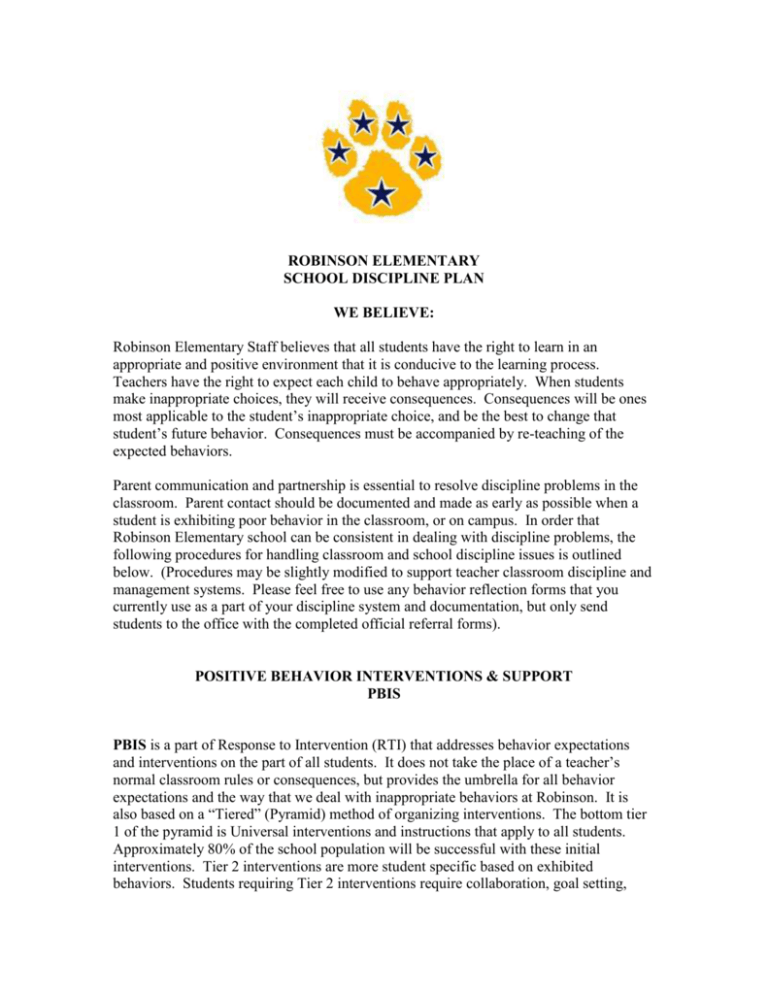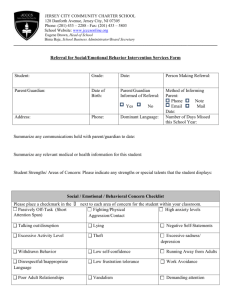discipline plan
advertisement

ROBINSON ELEMENTARY SCHOOL DISCIPLINE PLAN WE BELIEVE: Robinson Elementary Staff believes that all students have the right to learn in an appropriate and positive environment that it is conducive to the learning process. Teachers have the right to expect each child to behave appropriately. When students make inappropriate choices, they will receive consequences. Consequences will be ones most applicable to the student’s inappropriate choice, and be the best to change that student’s future behavior. Consequences must be accompanied by re-teaching of the expected behaviors. Parent communication and partnership is essential to resolve discipline problems in the classroom. Parent contact should be documented and made as early as possible when a student is exhibiting poor behavior in the classroom, or on campus. In order that Robinson Elementary school can be consistent in dealing with discipline problems, the following procedures for handling classroom and school discipline issues is outlined below. (Procedures may be slightly modified to support teacher classroom discipline and management systems. Please feel free to use any behavior reflection forms that you currently use as a part of your discipline system and documentation, but only send students to the office with the completed official referral forms). POSITIVE BEHAVIOR INTERVENTIONS & SUPPORT PBIS PBIS is a part of Response to Intervention (RTI) that addresses behavior expectations and interventions on the part of all students. It does not take the place of a teacher’s normal classroom rules or consequences, but provides the umbrella for all behavior expectations and the way that we deal with inappropriate behaviors at Robinson. It is also based on a “Tiered” (Pyramid) method of organizing interventions. The bottom tier 1 of the pyramid is Universal interventions and instructions that apply to all students. Approximately 80% of the school population will be successful with these initial interventions. Tier 2 interventions are more student specific based on exhibited behaviors. Students requiring Tier 2 interventions require collaboration, goal setting, data collection, and parent involvement. These interventions will be necessary for approximately 15% of our population. Finally, Tier 3 (Tip of the pyramid) students will require the most intensive interventions for 5% of our population. These interventions require extensive collaboration, FBA, data driven, and parental involvement. These students may require or may be in more restrictive environments within the school setting. In order for PBIS interventions to be successful, we must base our work on two key factors: 1. In order for students to exhibit desired behaviors, we must first teach all students how to behave successfully in key areas of the school. These areas were identified by staff and lesson plans were developed. (See Matrix and Lesson Plans) 2. That we as adults and staff members must model appropriate behavior and handle behavior correction positively to educate students. Appropriate staff conduct when dealing with students is expected at all times. (See “Tips for For implementing consequences”) *Students that have repeatedly not responded to Tier 1 instruction and re-teaching should be reported to the principal. The principal and the teacher will begin to establish a plan for Tier 2 interventions. MINOR DISRUPTION (Flow Chart: Classroom Managed) Please use a progressive discipline system that works with your classroom. Students should be given consequences that are gradually more severe with the ultimate goal of having the student change his or her behavior and continue with normal activities. (A good faith effort for Parent Contact should be made and documented for any continuing behavior problems. This means either face to face or phone contact. After a good faith effort has been made for either phone calls or face to face meetings, notes may also be mailed or sent home as well). Please initiate re-teaching of the Classroom Expectations Lesson Plan. During classroom interventions, a student may be removed to another classroom (K-2 teachers partner together and 3-5 teachers partner for time out rooms) for a period of time long enough to regroup and or reflect to change behavior ( period of time should not exceed 30min). Should the student disrupt the partner teacher’s classroom, the student will be returned to their regular class and that classroom teacher will decide weather the student can rejoin the class, or that the disruption is major and the student must be sent to the office with a referral or to speak with the principal. If the student is able to return to class, please arrange a time for the re-teaching of the Classroom Expectations Lesson Plan for that student. (Parent contact should be made and documented.) After classroom interventions have been exhausted and parent contact has been made, teachers may choose to fill out a referral if the student has a minimum of 3 documented incidents of the same minor offense. (See Flow Chart) *ALL Office Managed offenses- student should be sent to the office with a referral immediately. *Staff will use the white referral form that is in triplicate for all referrals. (See Flow Chart: Office Managed Offenses) PLAYGROUND BEHAVIOR Appropriate playground behavior is essential to the safety and well-being of all our students. At the beginning of the school year, students will be taught appropriate playground and equipment rules. Students who have problems on the playground will receive appropriate consequences and teachers and parents will be informed of playground problems. Playground aides will use verbal warnings, “On the wall” time outs and office referrals. When a student has been given a chance to correct playground behavior and fails to do so, his or her behavior will be documented on a referral. The principal will assign consequences and arrange for re-teaching of playground behavior. The discipline plan short version! : Consult Flow Chart on following page. 1. Use multiple classroom interventions when students make poor behavior choices. Document all interventions! 2. Make and document parent contact for behavior problems. Partner with parents! 3. Consult Flow Chart when interventions have failed to correct minor infractions. 3 minor infractions of the same behavior with parent contact will result in a referral. 4. Use a partner teacher classroom for time-outs. Do not send students to the office or hallway for time-out purposes. If the student is disruptive in another classroom or can not regain his or her ability to rejoin the group, or the student has exhibited such major disruption that you feel they will not be successful in another classroom, they may then be sent to the office with a referral. Please make parent contact later that day. 5. Serious offenses (200, 300 level) send immediately to the office with a referral. (See Flow Chart) FLOW CHART Observe Problem Behavior Problem Solve with Student Use classroom consequence No Document minor incident report No Does student have a minimum of 3 or more prior minor offenses of the same behavior? Is Behavior Office Managed? Yes Write referral to office Yes Re-teach expected behavior Contact Parent &Document! Write the student an office referral Classroom Managed *Minor Disruption *Not prepared for class *Minor disrespect *Not complying with teacher directions (Minor defiance) *Disrespecting property (minor) *Toys: Stuff from home that causes distraction *sleeping *Negative attitude *Cheating (first time) *tardiness/ attendance *minor student conflicts Office vs. Managed *Fighting *profanity *Weapons *Drug/Alcohol possession *Major Threats *Harassment/Bullying *Theft *Vandalism *Major Disruption *Major disrespect (swearing at or threatening adult) *Physically aggressive contact with an adult or staff member. *** After reviewing evidence, students who commit these infractions will receive a 1-5 day suspension from school. Administrator Determines Consequence Administrator Follows Through with Consequence Administrator Provides Teacher Feedback S.T.A.R. Students at Robinson are held to behavior expectations that fall under one of the following categories: 1. 2. 3. 4. Safety Trustworthiness A+ Attitude Respect & Responsibility All students should be taught what STAR means and should be held accountable for each category. All students will receive instruction in expected STAR behaviors through designed lesson plans created for identified areas of the building such as: Hallway, Restroom, Lunch room, Lines, Classroom, Office, Library and Playground. Students who have problems following set expectations will initially receive re-teaching in the applicable area, and may be referred to begin Tier 2 interventions. Students will receive instruction beginning on the first day of school. All students should have completed each lesson plan within the first two weeks of school. *A major component to PBIS is also recognizing students who are exhibiting appropriate behaviors. Please give positive comments and or recognition to the student through Cougar Character Tickets, STAR awards etc…. Please take the time to recognize ANY student you see who shows STAR behavior! As a staff we will all correct and remind students of appropriate behaviors by using common language. See the lesson plans for each area. We will remind students by using the word “________Basics” Depending on the area. Staff may also remind students of “STAR” behavior and teach why the behavior violates a particular area under STAR. 1. 2. 3. 4. 5. 6. 7. “Line Basics” “Hallway Basics” “Restroom/Bathroom Basics” “Lunchroom Basics” “Playground Basics” “Classroom Basics” “Office Basics” Classrooms who exhibit STAR behavior will win the privilege of displaying the STAR banner on their classroom door. Other incentives for positive behavior will be established throughout the year.







